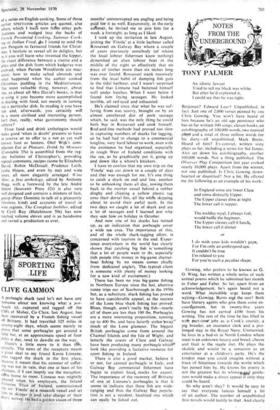CLIVE GAMMON
A porbeagle shark (and let's not have any nonsense about not knowing what:a por- beagle is), captured and tagged off the Cliffs of Molter, Co Clare, last 'August, has been recovered by a French fishing vessel off Brittany. It had travelled 325 miles in seventy-eight days, which seems merely to prove that some porbei,gles get -around a little but, at an approximate speed of four ,miles a day, -tend to dawdle on the way. - There's a little more to it than tlits, actually. The news. of the recapture meant a great deal to my friend Kevin Linnane, who tagged the 'shark in the first place, because it meant. that his-summer of suffer- ing was not in vain, that one at least of his chickens,. if I can ineptly use the' metaphor, cane home to roost. Linnane was mightily Pleased when. his employers, the Inland Fisheries Trust of Ireland, commissioned the stv `Finola' as a research vessel and set hIrri to skipper it and. take charge of their shark survey. He had a golden vision of three months' uninterrupted sea angling and being paid for it as well. Expansively, in the early suihmer, he invited me to join him for a week, a fortnight, as long as I liked.
I took up the invitation in late August, joining the Tinbla' at a little harbour called Rossaveel on Galway Bay where a couple of years previously somebody (of whom the local lobster fishermen knew nothing) dynamited an alien lobster boat in the middle of the night so effectively that no piece of timber more than six inches long was ever found. Rossaveel stank massively from the local habit of dumping fish guts in the tidal harbour, and I wasn't surprised to find that Linnane had battened himself well under hatches. When I went below I found him frying sausages. He looked terrible, all red-eyed and exhausted.
He's claimed since that what he was suf- fering from was scurvy, brought on by an almost unrelieved diet of pork sausage which, he said, was the only thing he could both buy in Rossaveel and cook himself. Rod-and-line methods had proved too slow in Capturing numbers of sharks for tagging, so he had, had to change to a commercial longline, very hard labour to work, even with the assistance he had organised, especially in rough West of Ireland conditions with the sea, as he graphically put it, going up and down like a whore's knickers.
I have to confess that my own trip on the Tinola' was cut down to a couple of days and that was enough for me. It's one thing to catch a shark on rod and line, another to be unhooking them all day, towing them back to the mother vessel behind a rubber dinghy and clipping a yellow plastic tag onto their dorsal fins, all the white skipping about to avoid their awful teeth. In the two days we caught a lot of shark and ate a lot of sausages and I learned just why they sent hint on holiday in October.
And now one of his sharks has turned up, -as an indication that porbeagle cover a wide sea area. The importance of this, and of the whole shark-tagging effort, is concerned with tourism in the end. Exper- ience everywhere in the world has clearly shown that catching big fish is 'something that a lot of people want to do, especially rich people (the money in big-game charter- boat fishing by no means comes chiefly from dedicated anglers. The. typical' client is someone with plenty of money looking for a new kind of excitement.)
There has been no true big-game fishing in Northern Europe since the last, abortive tunny trips out of Scarborough in the 1950s but, as a substitute, shark fishing has proved to have considerable appeal, as the success of the Looe blue shark fishing has proved. Blues, though, aren't 'really big fish—nearly. all of them ,are less than 100 lbs. Porbeagles are a more interesting proposition, running up to 400 lbs, and have latterly stolen /mays' much of the Looe glamour. The biggest British .porbeagles come from around the Channel Islands and the Isle of Wight; and latterly- the coasts of Clare and Galway have been producing many porbeagle which look like providing a lucrative resource for sport fishing in Ireland.
There is also a good market, believe it or not, for canned porbeagle in Italy, and Galway Bay commercial fishermen have begun to exploit local stocks for export. The importance of the recovery off Brittany of one of Linnane's porbeagles, is that it seems to indicate that these fish are wide- ranging and thus the Galway Bay popula- tion is not a resident, localised one which' can easily be fished out.














































 Previous page
Previous page